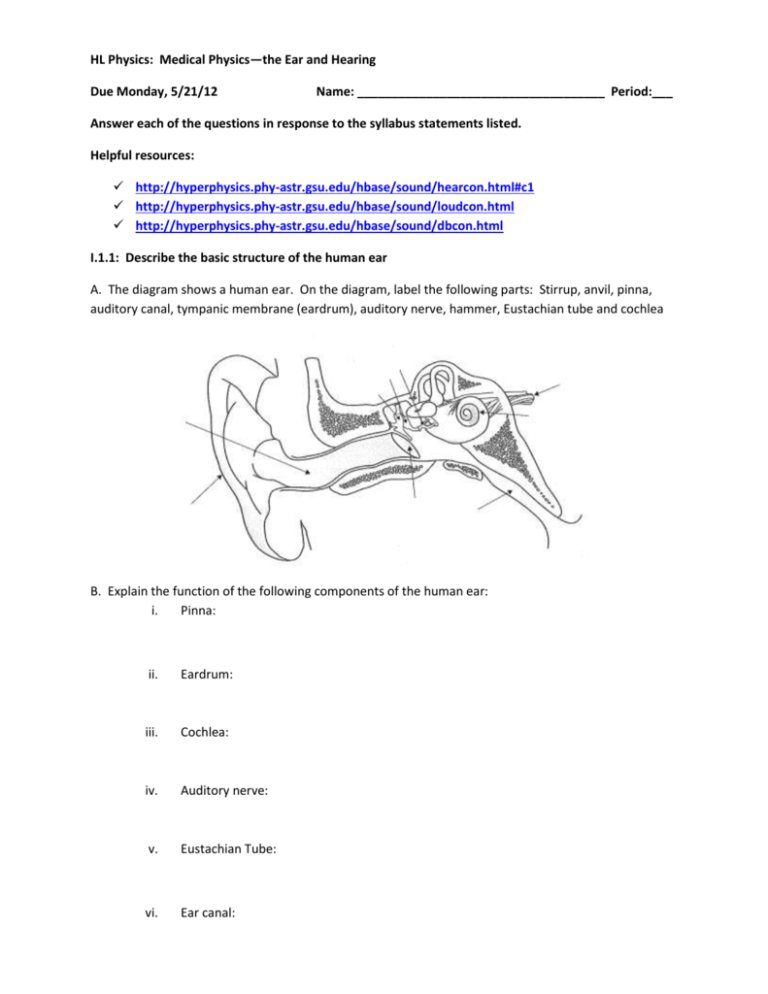Ear and Hearing - Issaquah Connect
advertisement

HL Physics: Medical Physics—the Ear and Hearing Due Monday, 5/21/12 Name: ____________________________________ Period:___ Answer each of the questions in response to the syllabus statements listed. Helpful resources: http://hyperphysics.phy-astr.gsu.edu/hbase/sound/hearcon.html#c1 http://hyperphysics.phy-astr.gsu.edu/hbase/sound/loudcon.html http://hyperphysics.phy-astr.gsu.edu/hbase/sound/dbcon.html I.1.1: Describe the basic structure of the human ear A. The diagram shows a human ear. On the diagram, label the following parts: Stirrup, anvil, pinna, auditory canal, tympanic membrane (eardrum), auditory nerve, hammer, Eustachian tube and cochlea B. Explain the function of the following components of the human ear: i. Pinna: ii. Eardrum: iii. Cochlea: iv. Auditory nerve: v. Eustachian Tube: vi. Ear canal: C. What is the main function of the: i. Inner Ear: ii. Middle Ear: I.1.2: State and explain how sound pressure variations in air are changed into larger pressure variations in the cochlear fluid A. The cross-sectional area reduced from the pinna through the auditory canal and then the inner ear. Explain what consequence this has on the pressure in the tubes. B. Soundwaves are received by the pinna and are eventually transmitted to the brain by a series of pressure variations. Arrange the following components in the correct sequence at which soundwaves travel from the pinna to the brain: Pinna, Ossicles, oval window of the inner ear, movement of hair cells, auditory canal, auditory nerve, eardrum, cochlear fluid, brain C. Briefly describe what is meant by the term ‘acoustic impedence” of an ear component I.1.3: State the range of audible frequencies experience by a person with normal hearing: A. What is the normal range human hearing? B. What term is given for those sounds with frequencies lower than the limit of human hearing? Give multiple examples of sources of this type of sound wave: C. What term is given for those sound waves generated at a frequency higher than the limit of normal human hearing? Give multiple examples of sources of this type of soundwave: I.1.4: State and explain that a change in observed loudness is the response of the ear to a change in intensity I.1.5: State and explain that there is a logarithmic response of the ear to intensity. A. Referring to the structure of the ear, explain why frequencies below the threshold are not heard. B. Which of the following statements best describes the relationship between pitch, amplitude, frequency and intensity? a. Higher the frequency, higher the pitch. Lower the amplitude, higher the intensity. b. Higher the frequency, hlower the pitch. Lower the amplitude, lower the intensity. c. Higher the frequency higher the pitch. Lower the amplitude, lower the intensity. d. Higher the frequency, higher the pitch. Higher the amplitude, lower the intensity. C. The four graphs below each show a travelling sound wave. The graphs are drawn to the same scale. a. Which graph depicts the loudest sound? b. Which graph depicts the highest frequency? D. Referring to resonance, explain why the human ear is typically most sensitive to sounds at a frequency of about 2000 Hz. I.1.6: Define Intensity and intensity level I.1.7: State the approximate magnitude of the intensity level at which discomfort is experienced by a person with normal hearing I.1.8: solve problems involving intensity levels A. Which one of the following statements best describes the term intensity of a soundwave? a. Energy of a wave per cross-sectional area b. Energy of a wave per cross-sectional area every second c. Energy of a wave per second d. Power of a wave per second B. Define a mathematical statement for sound intensity level, listing all relevant terms in the expression. C. Explain what is meant by ‘threshold of hearing’ D. What is the sound intensity level (dB) of a soundwave of intensity 10-6 W·m-2? E. What is the intensity of a soundwave of 80 dB? F. Two soundwaves each of 70 dB add up at a point to create a new soundwave. What will be the intensity at that point of the new wave? G. A tuning fork produces 30 compressions of surrounding air particles in 15 ms. The distance between 100 compressions is 15 m. Use this data to complete the following sentence: The soundwave has a wavelength of __________________ m, a frequency of _______________Hz and a speed of ________________________ m·s-1 H. A frequency synthesizer is used to generate the widest range of frequencies a student can hear. For each frequency measured, the student records the sound intensity that he could just hear an any intensity less than this was inaudible. The data obtained is shown in the graph. On the yaxis, 1.00E-06 means 1 x 10-6. a. At about 1500 Hz, the sound intensity level is the lowest. At this frequency, is the hearing most sensitive or least sensitive? b. What is the intensity at the student’s ear at 10,000 Hz? At what other frequency dies he experience the same intensity? c. What is the total range of frequencies the student could hear? d. An observer is listening to the 100 Hz note and is just able to hear it. The frequency is now changed to 50 Hz. What is the intensity of the note that he can just hear at 50 Hz? e. What is the difference in sound intensity levels between the two notes described in question d at the intensities listed in question d? I. A person records an intensity of 10-5 W·m-2 on a normal surface area of 120 cm2. What is the incident energy in a time of 1.0 min.? I.1.9: Describe the effects on hearing of short-term and long-term exposure to noise I.1.10: Analyze and give a simple interpretation of graphs where IL is plotted against the logarithm of frequency for nor mal and for defective hearing. A. Briefly describe what a cochlear implant does. B. Discuss the symptoms, cause and treatment of tinnitus. (http://www.webmd.com/a-to-z-guides/tinnitus-directory )







